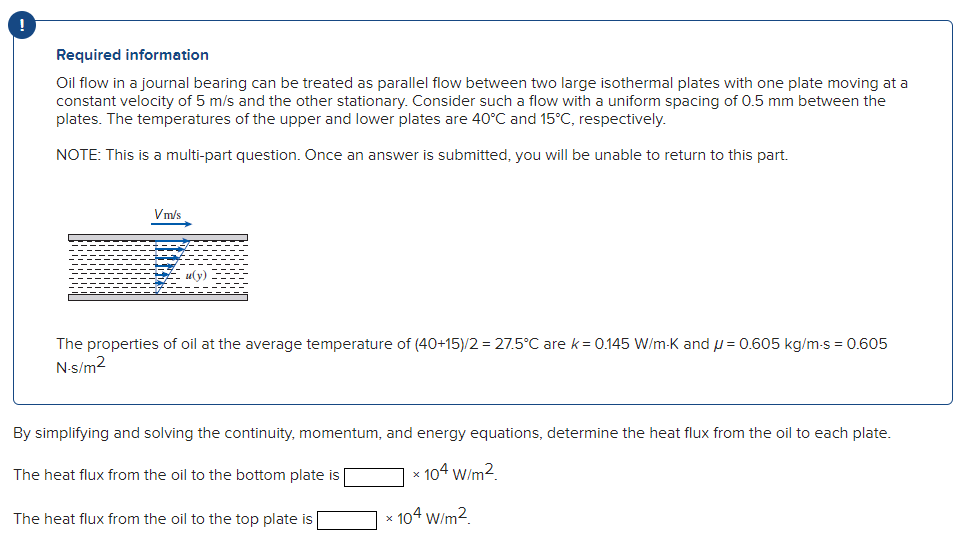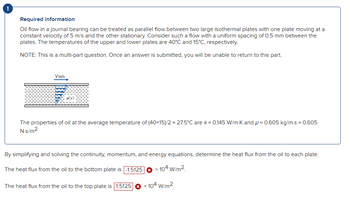Oil flow in a journal bearing can be treated as parallel flow between two large isothermal plates with one plate moving at a constant velocity of 5 m/s and the other stationary. Consider such a flow with a uniform spacing of 0.5 mm between the plates. The temperatures of the upper and lower plates are 40°C and 15°C, respectively. NOTE: This is a multi-part question. Once an answer is submitted, you will be unable to return to this part. Vm/s The properties of oil at the average temperature of (40+15)/2 = 27.5°C are k = 0.145 W/m-K and = 0.605 kg/m-s = 0.605 N-s/m² By simplifying and solving the continuity, momentum, and energy equations, determine the heat flux from the oil to each plate. The heat flux from the oil to the bottom plate is * 104 W/m² The heat flux from the oil to the top plate is [ * 104 W/m².
Oil flow in a journal bearing can be treated as parallel flow between two large isothermal plates with one plate moving at a constant velocity of 5 m/s and the other stationary. Consider such a flow with a uniform spacing of 0.5 mm between the plates. The temperatures of the upper and lower plates are 40°C and 15°C, respectively. NOTE: This is a multi-part question. Once an answer is submitted, you will be unable to return to this part. Vm/s The properties of oil at the average temperature of (40+15)/2 = 27.5°C are k = 0.145 W/m-K and = 0.605 kg/m-s = 0.605 N-s/m² By simplifying and solving the continuity, momentum, and energy equations, determine the heat flux from the oil to each plate. The heat flux from the oil to the bottom plate is * 104 W/m² The heat flux from the oil to the top plate is [ * 104 W/m².
Principles of Heat Transfer (Activate Learning with these NEW titles from Engineering!)
8th Edition
ISBN:9781305387102
Author:Kreith, Frank; Manglik, Raj M.
Publisher:Kreith, Frank; Manglik, Raj M.
Chapter7: Forced Convection Inside Tubes And Ducts
Section: Chapter Questions
Problem 7.13P
Related questions
Question

Transcribed Image Text:Required information
Oil flow in a journal bearing can be treated as parallel flow between two large isothermal plates with one plate moving at a
constant velocity of 5 m/s and the other stationary. Consider such a flow with a uniform spacing of 0.5 mm between the
plates. The temperatures of the upper and lower plates are 40°C and 15°C, respectively.
NOTE: This is a multi-part question. Once an answer is submitted, you will be unable to return to this part.
Vm/s
uy)
The properties of oil at the average temperature of (40+15)/2 = 27.5°C are k= 0.145 W/m-K and = 0.605 kg/m-s = 0.605
N-s/m²
By simplifying and solving the continuity, momentum, and energy equations, determine the heat flux from the oil to each plate.
The heat flux from the oil to the bottom plate is
* 104 W/m²
The heat flux from the oil to the top plate is
* 104 W/m².
Expert Solution
This question has been solved!
Explore an expertly crafted, step-by-step solution for a thorough understanding of key concepts.
This is a popular solution!
Trending now
This is a popular solution!
Step by step
Solved in 7 steps with 14 images

Follow-up Questions
Read through expert solutions to related follow-up questions below.
Follow-up Question
Please help answer the question show. The topic is heat transfer. Thank you.

Transcribed Image Text:!
Required information
Oil flow in a journal bearing can be treated as parallel flow between two large isothermal plates with one plate moving at a
constant velocity of 5 m/s and the other stationary. Consider such a flow with a uniform spacing of 0.5 mm between the
plates. The temperatures of the upper and lower plates are 40°C and 15°C, respectively.
NOTE: This is a multi-part question. Once an answer is submitted, you will be unable to return to this part.
Vm/s
u(y)
The properties of oil at the average temperature of (40+15)/2 = 27.5°C are k = 0.145 W/m-K and = 0.605 kg/m-s = 0.605
N-s/m²
By simplifying and solving the continuity, momentum, and energy equations, determine the heat flux from the oil to each plate.
The heat flux from the oil to the bottom plate is -1.5125 x 104 W/m².
The heat flux from the oil to the top plate is 1.5125 x 104 W/m².
Solution
Knowledge Booster
Learn more about
Need a deep-dive on the concept behind this application? Look no further. Learn more about this topic, mechanical-engineering and related others by exploring similar questions and additional content below.Recommended textbooks for you

Principles of Heat Transfer (Activate Learning wi…
Mechanical Engineering
ISBN:
9781305387102
Author:
Kreith, Frank; Manglik, Raj M.
Publisher:
Cengage Learning

Principles of Heat Transfer (Activate Learning wi…
Mechanical Engineering
ISBN:
9781305387102
Author:
Kreith, Frank; Manglik, Raj M.
Publisher:
Cengage Learning